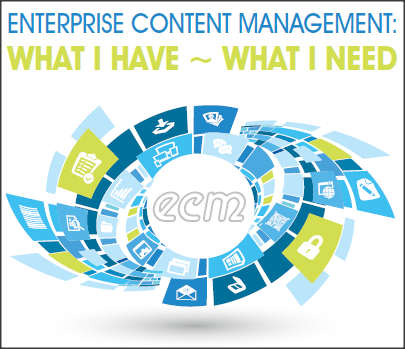AIIM Studien | Herbst 2016
20. Oktober 2016 15:57 Uhr | PROJECT CONSULT Webmaster | Permalink
Der internationale ECM-Dachverband AIIM International hat im Sommer und Herbst wieder zahlreiche Studien, Whitepaper, Infographiken und Tip-Sammlungen veröffentlicht, die auch für Europa und Deutschland relevant sind. Dazu gehören Studien zu Sicherheit, Sharepoint, elektronischer Signatur, Enterprise Content Management, Cloud und zum WPFD World Paper Free Day.
Die Veröffentlichungen der AIIM Association for Image and Information Management sind eine wahre Fundgrube zu Details und Daten des Marktes Enterprise Content Management und Enterprise Information Management. Auch hier zeichnen sich die neuen Themen rund um IoT, Künstliche Intelligenz, Mobile, Information Governance und andere bereits ab und werden mit erhobenen Daten unterlegt.
Folgende zwölf aktuelle AIIM Whitepaper und sechs "John Mancini Tip Sheets" werden vorgestellt und können kostenfrei heruntergeladen werden. Die Kurz-Links führen dabei auf die AIIM Webseite und auf Dokumentationen bei PROJECT CONSULT. Die Übersicht zu den jeweils aktuellsten Whitepaper auf der AIIM-Webseite findet sich hier: http://bit.ly/AIIMresearch
Industry Whitepaper
- Elektronische Signaturen in Europa: Einblick in rechtliche Aspekte zum Nachweis von Willenserklärungen
- The Impact of SharePoint – 2016
- The Agile Enterprise: A Welcome Change
- Information Security: Checking the Locks
- Information Security: Staying Vigilant
- Trendscape: Infonomics – How Do You Measure the Value of Information
- Managing Content Beyond the Corporate Walls
- What's Happening with File Sync and Share?
- Digital Revolution in the Financial Sector
- Paper-Free in 2016 – Are we there yet?
- Enterprise Content Management: What I Have – What I Need
- Healthcare Information Security: Prevention is the Cure
Tip Sheets:
- 7 Tips to Create MORE Information Chaos
- 6 Things You Need to Know About Emerging Markets and Information Management
- 3 Reasons Why Document Processing Should Matter to the C-Suite
- 4 Steps to Leverage What You Already Have and Know to Improve Customer Experiences
- 5 Faces of Information Chaos
- 3 Questions to Ask About Content Creation
Studien, Whitepaper und Infographics
 Elektronische Signaturen in Europa: Einblick in rechtliche Aspekte zum Nachweis von Willenserklärungen
Elektronische Signaturen in Europa: Einblick in rechtliche Aspekte zum Nachweis von Willenserklärungen
Ausnahemsweise einmal ein Whitepaper der AIIM in deutscher Sprache (eine englische Version gab es schon in unserer "Sommer-Liste"). Dementsprechend gibt es hierin auch Informationen zu eIDAS und zur elektronischen Signatur in Deutschland.
"Die meisten Kunden kommunizieren heute online und mobil. Dementsprechend sind die Erwartungen an die Geschäftsbereiche der Unternehmen mit denen sie kommunizieren: Möglichst überall, jederzeit und über alle Kanäle, einschließlich Smartphones und Tablets, möchten sie geschäftliche Transaktionen einfach und problemlos erledigen. Das Selbe erwarten die Mitarbeiter von Unternehmen bei internen Arbeitsabläufen. Das Ausdrucken von Dokumenten um sie auf Papier zu unterschreiben, empfinden sowohl Kunden wie auch Mitarbeiter als umständlich und lästig…
Download bei AIIM: bit.ly/ESIGLEGAL
Inhalt
- Über dieses Whitepaper
- Einführung
- Rechtliche Rahmenbedingungen für den Einsatz
- elektronischer Signaturen verstehen
- Die Auswirkungen von eIDAS
- Merkmale vertrauenswürdiger elektronischer Signaturverfahren
- Beispiele von Anwendungen elektronischer Signaturen in Europa
- Fazit
Fazit der AIIM in der Studie "Elektronische Signaturen in Europa: Einblick in rechtliche Aspekte zum Nachweis von Willenserklärungen" vom August 2016
Obwohl elektronisches Unterschreiben rasch weiter an Akzeptanz gewinnt, zunehmend eingesetzt wird und Verordnungen wie eIDAS zusätzlichen Rückenwind bringen, gibt es keinen einzelnen, standardisierten Ansatz zum Einsatz elektronischer Signaturen in Europa der sich für alle Anwendungszwecke gleichermaßen eignet. Die EU-Verordnung 910/2014 minimiert jedoch die bisher vorherrschende Verwirrung und Komplexität für Unternehmen, die multinational agieren. eIDAS liefert Unternehmen, die elektronische Signaturen einsetzen möchten Anhaltspunkte funktionaler Anforderungen bei der Auswahl möglicher Anbieter. Lösungen mit denen sich Prozesse erstellen lassen die eIDAS-kompatibel sind können in allen Ländern der Europäischen Union eingesetzt werden sowie in Ländern die aufgrund enger vertraglichen Bindungen zur Europäischen Union mit ihr stark verknüpft sind, wie Norwegen oder der Schweiz.
Diese Vorschriften wurden zum 1. Juli 2016 wirksam. So ist es zwingend erforderlich, dass sich die Unternehmen nicht nur die Zeit nehmen, die Vorschriften selbst zu verstehen, sondern auch welche Auswirkungen diese haben, sowohl für Unternehmen die a) bereits Lösung für elektronisches Signieren einsetzen oder b) einen Nutzung planen. Wer bereits Lösungen für das elektronische Signieren einsetzt,
sollte sicherstellen, dass diese die Vorschriften erfüllen. Unternehmen, die eine Nutzung planen, sollten sicherstellen, dass diese die rechtlichen Rahmenbedingungen einhält. Sie können eIDAS als eine der Grundlagen für ihre funktionalen Anforderungen im Auswahlprozess verwenden.
 The Impact of SharePoint – 2016
The Impact of SharePoint – 2016
Jedes Jahr wird das Thema Sharepoint neu aufgegriffen. Deutlich wird, wie Microsoft immer mehr die Lösungen in die Cloud verlegen will. ECM-Lösungen in Ergänzung von Sharepoint spielen aber auch Inhouse weiterhin eine große Rolle.
"The SharePoint platform has evolved over time, positioning to become a digital workspace and universal interface of sorts. SharePoint is being used in support of collaborative efforts of all kinds including co-authoring of documents, information sharing, and an integration point with all enterprise information sources. In this study, we find that there is a slight increase over last year of SharePoint use in an Enterprise Content Management (ECM) and Document Management (DM) role with 28% of respondents citing it is their only (10%) or main (18%) ECM/DM system…"
Download bei AIIM: bit.ly/SPImpact16
Die Executive Summary finden sie hier.
Inhalt
- About the Research
- Process Used and Survey Demographics
- About the author
- Introduction
- General Perspectives
- Project Status
- User Perceptions
- The Cloud
- Add-on Products
- Governance
- Futures, Spend, and Opinions
- Conclusion and Recommendations
- Appendix 1: Survey Demographics
- Appendix 2: General Comment
"Keyfindings" der Studie "The Impact of SharePoint – 2016" vom Juli 2016
General Perspectives
- SharePoint is the only or main ECM/DM system for 28% of organizations. Thirteen percent see SharePoint as important for their overall ECM/DM environment.
- Eleven percent of organizations have reached a plateau in terms of SharePoint adoption. 22% say their SharePoint adoption is facing challenges from the user community.
- More than a quarter of respondents say they are still using SharePoint 2010 with 41% citing they are using SharePoint 2013 as their live primary version. At this time, only 2% say they are live with SharePoint 2016 and 19% with SharePoint Office 365.
- When it comes to the enhancements found in SharePoint 2016, 43% say they are somewhat aware of what SharePoint 2016 offers, while 29% indicate they have no awareness at all. Only 23% of respondents indicate they understand what SharePoint 2016 offers.
Project Status
- Forty percent of organizations say their SharePoint implementation was not a success. Inadequate user training (67%), hard to use (66%), and lack of senior management support (64%) are cited as reasons for SharePoint projects stalling or failing.
- Revitalization of their SharePoint project through user training is a priority for 58% of organizations, while 50% plan to update and enforce their Information Governance policies in relation to SharePoint. For 35% the focus is on positioning and reconfirming that SharePoint is or will be their primary ECM system.
User Perceptions
- When looking at SharePoint as an ECM/DM solution, 43% prefer using their file-share application for everyday content. When looking at SharePoint as a collaboration tool, 58% say it is popular for project and team site use.
- Functionally, 50% say that internal facing SharePoint sites are in wide use, as are the collaboration and team sites (44%). However, when it comes to email management with SharePoint, 76% say they do not use it.
- Looking at SharePoint from a process and enterprise connectivity perspective, 72% of organizations show no support for mobile device use. Nearly a quarter say they widely use enterprise search, and 19% cite wide use of SharePoint for review and approval processes.
- While support for mobile seems lacking, 40% say a mobile application of SharePoint is very important for controlled document access. Thirty-five percent see a mobile application of SharePoint as important in providing intranet capabilities on a mobile device.
- Change management is a major issue for 58% of organizations challenged with user reluctance to use SharePoint, more so than the lack of technical expertise cited by 51%. More than one-third say it is inconsistent metadata and classifications presenting the biggest issue for their organization.
Cloud/Mobile/Access
- Twenty-three percent of organizations plan a hybrid environment with the majority of their information hosted on SharePoint Online/365 with some remaining on-premise. For 17%, the plan is to move everything to Microsoft’s hosted SharePoint Online/365.
- Nearly one-third of organizations see a move to the cloud/365 as a strategic platform vision, while 22% see it as taking advantage of the latest SharePoint updates. Twenty-nine percent view a move to the cloud/365 as a move toward cost savings in IT.
- When it comes to cloud use, 31% of organizations are using SharePoint 365/SharePoint Online. When asked about issues or concerns with using a cloud or hybrid SharePoint solution, 58% feel security is an issue, while 53% feel control over what is managed in the cloud is an issue.
- Accessing SharePoint is done from home using a VPN connection for 50% of respondents, while 36% say they get there through their Outlook client. Outside access to SharePoint is discouraged by 15% of organizations.
Add-ons and Enhancements
- SharePoint out-of-the-box is good for 64% of organizations. Widgets and web parts (51%), and 3rd party add-on products (32%), are also in play for SharePoint optimization.
- Regarding 3rd party SharePoint add-on products, 30% of organizations plan to implement storage and archive management with 11% citing it is in use now. Twenty-eight percent plan to have integration with Outlook, while 23% say this is already in place today.
- Organizations are planning for and implementing SharePoint auxiliary products for data migration (50%), and an additional 24% say they are using this now. Some organizations (23%) see the benefit in planning for and using (13%) SharePoint Auxiliary products for digital signatures.
Governance
- Twenty-five Percent of organizations do not differentiate records from content, with 21% admitting they do not have good Information Governance (IG) policies in place. Thirty-percent say they do not capture records, while 15% say they use a combination of SharePoint Records Center and managein- place to do so.
- When asked how SharePoint aligns to their IG policies, 80% say their metadata and taxonomy (45%) are not aligned, or there are no policies (35%). Sixty-two percent cite retention and disposition as their main misalignment with their IG policies.
Futures, Opinions, and Spend
- Twenty-nine percent of organizations will build ECM, DM, and collaboration around SharePoint, with 10% planning to move to SharePoint 2016. Twenty-seven percent will increase spending to integrate with other repositories, while 26% will increase spending on add-on products.
- Looking at value versus costs, 40% agree and 8% strongly agree that they are happy with SharePoint and the on-going roadmap. 42% agree and 8% strongly agree that SharePoint provides good value to costs.
 The Agile Enterprise: A Welcome Change
The Agile Enterprise: A Welcome Change
Die Studie betrachtet den Wandel bei Enterprise Software unter dem Druck von Apps, Mobile und Cloud.
"Today, in the enterprise, nothing is ever at rest; everything is fast, and getting faster. From critical business processes, ECM and capture, to human resource management, marketing, or email – everything seems to be running at a breakneck pace. Work is always working, even if we aren’t. Attempts to keep up with the increasing speed of the enterprise by many organizations have, conversely, slowed things down…"
Download bei AIIM: bit.ly/AgileEnterprise
- Introduction
- Integration and Interoperability
-
Goodbye Enterprise Software,
Hello Apps with K2 - A Look Back
- Hello, Business Apps with K2
- Conclusion and Recommendations
Fazit der AIIM in der Studie "The Agile Enterprise: A Welcome Change" vom Juli 2016
Accelerating the enterprise through automation, technology, and change management is necessary in order to keep pace with the changing business and technology landscapes, as well as stay ahead of the competition. It is no longer feasible to arbitrate business decisions on a multiple month or multiple year timeframe. Technology obsolescence is fast, the market is difficult to predict, and solutions that worked yesterday may not cut it today. More pressingly, the cost of failure is high, and the risk of providing a solution that doesn’t solve the problem is higher still. So what kinds of solutions should be deployed to solve critical business problems and be successful?
 Information Security: Checking the Locks
Information Security: Checking the Locks
In zwei Studien geht AIIM besonders auf die Fragen der Datensicherheit und des Datenschutzes ein. Besonders durch Digitalisierung, mobile Nutzung, Einbindung von Geschäftspartnern und immer mehr Information außerhalb der IT des Unternehmens selbst sind aktuelle Herausforderungen.
"The current direction of the enterprise is digital transformation. Digitalization promotes an efficient information lifecycle that facilitates access to critical information – wherever and whenever it is needed – in a way that wouldn’t be possible with physical mediums. However, proactive measures need to be taken to mitigate the risk of information security breaches even for organizations who have “gone digital.” A security breach is a potential threat for all organizations regardless of size or industry. It is critical to assess your organization’s risk for a cyber-attack or a security breach, as well as its ability to protect and defend sensitive information. How prepared is your organization to deal with an information security breach?"
Download bei AIIM: bit.ly/infoSec1
Inhalt
- Introduction
- Rising Risk
- Vulnerabilities
- Challenges
- Conclusion
Zusammenfassung der AIIM der Studie "Information Security: Checking the Locks" vom August 2016
Information security risks must be managed to limit monetary losses, disruption of operations, legal forfeitures, and damages to reputation. While awareness to cyber-attacks and hacking are well understood, significant effort must be directed towards protecting against internal threats to information security. The key to ensuring information security begins with diagnosis. Ask yourself the following questions about your organization:
- How does security in your organization measure up to best practices in information security?
- Where are the zones (departments, software, devices) of highest risk for security breaches in your company?
- Do employees receive adequate training about their role in maintaining information security and its importance in mitigating risk and threats to the company?
- What holds security improvement projects back in your organization?
Watch this space for our follow-up installment titled “Information Security: Guard against Disaster,” and learn proactive measures you can take to protect your organization against a security breach.
 Information Security: Staying Vigilant
Information Security: Staying Vigilant
Im zweiten Whitepaper zum Thema Informationssicherheit geht es um das Ereknnen und Bekämpfen von Lücken und Einbrüchen.
"In the wake of several high profile security breaches over the past few years, information security has rocketed to the top of enterprise to-do-lists. Risk and liability drive efforts to ramp up protection in an attempt to avoid consequences from a security breach. These consequences include lost revenue, critical files ending up in the wrong hands and intangibles like damages to brand, lost customer trust, or lowered reputation…"
Download bei AIIM: bit.ly/InfoSec2
Inhalt
- Introduction
- Information Insecurity
- Proactive Protection
- Technology
- Policy
- Culture
- Conclusion
Zusammenfassung der AIIM in der Studie "Information Security: Staying Vigilant" vom August 2016
While it is impossible to eliminate the risk of a security breach entirely, a coalition of the three principles – technology, policy, and culture – is the best course of action to protect against this dynamic threat. Keep these best practices in mind when implementing information security processes to prevent security breaches:
- Assess your organization’s unique technology requirements before acquiring new information security solutions.
- Establish a continuous review cycle of security policies.
- Identify how your company can best cultivate a culture of security awareness?
- Have executive consensus and sponsorship when executing information security policy in your organization.
- Provide equal attention to both external and internal threats.
 Infonomics: How do you measure the Value of Information?
Infonomics: How do you measure the Value of Information?
Der Wert der Information ist die entscheidende Frage, wenn es um Einrichtung von Lösungen, die Erschließung der Information als Wissen, die Bereitstellung in Prozessen und den Schutz der Informationen geht. Hioerzu wird der Begriff "Infonomics" eingeführt.
"If “information” is the currency of Digital Age, why don’t organizations manage their information assets with the same seriousness as their financial assets, their physical assets, and their human assets? Why is “Infonomics” such a difficult concept for organizations to grasp?"
Download bei AIIM: bit.ly/ValueInfo
- Introduction
- ELC June 2016 – Infonomics
- Conclusion #1 — Assigning a value to information assets is not as easy as it sounds.
-
Conclusion #2 — How you value information assets ultimately depends on:
1) the type of asset; and
2) how it is used. - Conclusion #3 — “Infonomics” has potential as an umbrella term for this discipline, but is still largely not well understood in the user community.
- Conclusion #4 — The accounting profession may force the question of the valuing of information assets, but likely not any time soon.
"Introduction" der AIIM der Studie "Infonomics: How do you measure the Value of Information?" vom
It seems obvious: In an age of Digital Transformation, the information assets of an organization are increasingly THE defining source of organizational value. There is a growing gap between the traditional ways we value organizations — in terms of the tangible and intangible assets reported in financial statements — and the value the market puts on organizations. Over and over, in the face of the latest acquisition, we ask ourselves, “How on earth could company X pay so much for company Y?”
According to Doug Laney from Gartner, in 1975, on average
the tangible assets of a corporation represented 83% of its value. Today that number is 20%. As a result, over 50% of merger and acquisition exchanges can’t be accounted for.
The most recent example is the Microsoft acquisition of LinkedIn. We look at the accounting value of LinkedIn — $3.2 billion in revenues — and compare it to the price paid by Microsoft — $26 billion — and
shake our heads and wonder:
- Is this a signal of another dot-com bubble?
- Why is the accounting value of the company so different from the market value?
- Is Microsoft crazy? Or crazy like a fox?
I believe that the core of this disequilibrium lies in our inability to properly measure and value the information assets of an organization. And this inability is reflected not only in a growing gap between what we report about companies and what we inherently know about companies, but also in systematically undervaluing the investments that companies make in processes to optimize information, protect it, and utilize it to create customer value. Simply stated, if you can’t measure it, you won’t value it.
 Managing Content Beyond the Corporate Walls: Working in the Cloud
Managing Content Beyond the Corporate Walls: Working in the Cloud
Das Thema Cloud und Mobile bewegt als Vision für die Zukunft des Büroarbeitsplatzes die Gemüter: ECM hat seine Zukunft in der Cloud. Gerade wenn Mitarbeiter an verschiedenen Standorten, zuhause, unterwegs, auf die gleichen Informationen, Dokumente und Prozesse zugreifen müssen, führt um die Cloud kaum ein Weg vorbei.
"Organizations are faced with the challenge of providing a flexible and secure environment supporting the agile needs of their remote workforce, partners, and clients. In fact, AIIM Research found that 30% of respondents are seeing increasing use of unofficial cloud content management and file shares. Only 5% indicated they have an “official” cloud-based option. 19% prevent access to non-approved sites."
Download bei AIIM: bit.ly/BeyondWall
Inhalt
- About the White Paper
- Introduction
- Access Management
- Information Capture
- Information Practices
- Preparedness
- Strategic Direction
- Conclusions and Recommendations
- Underwritten by
"Keyfindings" der AIIM in dem Whitepaper Studie "Managing Content Beyond the Corporate Walls: Working in the Cloud" vom September 2016
Access Management
- The majority of respondents (82%) cite they are still accessing content from corporate file shares and virtual drives. 74% are accessing their content from a corporate ECM system.
- iPhones (61%), iPads (53%), and Android Smartphones (49%) are the most commonly used mobile devices used for accessing documents. On the desktop, Windows PCs dominate while Macs fall way behind.
- The majority (67%) of respondents are looking at cloud to provide device agnostic access on a 24/7 basis. 51% say they see the driver for cloud as being a way to improve collaboration with 26% citing business continuity as a driver.
Information Capture
- When looking at multi-channel inbound content, 42% of respondents say things are adhoc in their organization and it is a struggle to match their on-premise and cloud content. For 32%, capture and processing of content is done on-premise and then moved to the cloud.
- In an effort to streamline operations, auto classification and workflow are being used to identify and route content to on-premise applications (30%). For 28%, there is a distributed capture network in place that feeds a single process or case file on-premise.
- When asked about the deployment of capture in the cloud, 36% say they have something in place now for documents and 32% for reports. An additional 40% have plans related to capturing documents, reports, and spreadsheets in the cloud.
Information Practices
- Looking at changes in content management practices over the next 5 years, 64% say they will be implementing a hybrid platform of on-premise and cloud. For 14% of respondents, there will be a move to a private hosted cloud.
- Focusing on managing corporate electronic records for meeting compliance requirements, 54% say they use on-premise systems. Use of a hybrid on-premise and cloud platform is the method of choice for 25% of respondents.
Preparedness
- Disparate systems are a challenge for most organizations and 30% of respondents say they are migrating to a single system. For 26%, the method of choice is to use clouds services and for 20% it is File Sync and Share
- The exponential growth of content is being addressed by implementing ECM/RM systems to replace their file shares according to 52% of respondents. Automation of retention policies and deletions is the direction for 35% while 35% indicate they will move to a hybrid model for storage.
Strategic Direction
- Moving to the cloud is on the scope for 54% within the next two years, with 23% of those respondents saying it will happen within 6 months. One quarter indicate they have no plans to move to the cloud at this time.
- Turning focus to capture in the cloud, 44% say this will happen within 2 years with 185 of those respondents citing it will happen within 6 months. At this time, 35% say they have no plans to implement capture in the cloud.
 What’s Happening with File Sync and Share?
What’s Happening with File Sync and Share?
EFSS Enterprise File Synchronsiation und Sahring ist unter Druck, da die Funktionalität immer mehr zur "Commodity" wird. EFSS-Anbieter entwickeln sich daher in RIchtung ECM in der Cloud weiter.
"There’s a growing demand by and for employees to share and collaborate on documents with people inside and outside of their organizations. As a result, businesses must carefully assess their file sharing needs. From customers and vendors to constituents and auditors, information must be made available
to a variety of stakeholders in a timely and secure manner to reach and maintain effective operations and service levels. It’s no longer “good enough” to rely on slow, asynchronous methods of collaboration… "
Download bei AIIM: bit.ly/FSyncShare
Infografik bei AIIM: bit.ly/FSS_IG
Inhalt
- About the White Paper
- Introduction
- Profile/Perceptions
- Policies and Procedures
- Integration and Interoperability
- Important Features
- Purchase Plans
- Conclusions and Recommendations
"Keyfindings" des Whitepapers "What’s Happening with File Sync and Share?" vom September 2016
Profile
- 38% of respondents say that 50% or more of their organization has a need to share files with someone outside of their organization. 29% say that 25% or less of the organization has this need to share.
- 58% of respondents say they are using third-party cloud apps for sharing outside of the corporate network, with 49% saying they use FTP sites. Not surprisingly, but somewhat concerning, is that 85% are still using email for this purpose
- When asked about standards for cloud-based sharing, 35% say they have some level of sanctioned file-sharing standard in place. 52% say there have no cloud-based sharing standards at all.
- Unsanctioned file sharing tools are in use by 65% of those polled. 35% say they are not aware of unsanctioned tools being used in their organization.
Policies and Procedures
- 21% of respondents say they have an information governance manager or director in place. IT is held responsible for ensuring proper use of tools, policies, and procedures for 45% of responding organizations.
- Lack of insight on what is being shared outside the company is a concern for 60% of organizations. Controlling who can share and data loss after termination of employment is of concern to 49% of organizations.
- Education is a key element in preventing unauthorized sharing for 65% of respondents. Monitoring of the user community is a practice for 46%.
Integration/Interoperability
- Opportunity for integration is there for the 50% of organizations indicating they have no integration between their file sync and share tool and their core applications. A tightly programmed integration is in place for 11% while 16% say they use add-on products.
- The ability to easily revoke a user’s rights, especially once they have left the organization, is a top feature sought by 77% of respondents. The ability to gain insight and audit file-sharing activities is high on the list for 60%.
- Security is on the minds of 71% of respondents, indicating that the use of unique encryption keys is very important. Assurance that their information is siloed from other clients of a cloud provider is considered very important for 65% of respondents.
 Digital Revolution in the Financial Sector
Digital Revolution in the Financial Sector
Besonders der Finanzsektor ist durch die DIgitalisierung unter Drucjk: Automatisierung, Customer Self-Service und nicht zuletzt Blockchain. Die Verbannung des Papiers aus den Prozessen hat hier besondere Bedeutung bekommen.
"The financial sector has made great strides in digitizing the customer experience. Banking for instance, is a majorly digital affair for most day-to-day banking undertaken by the consumer. However, the internal processes of many banks and financial institutions lag behind in the world of paper and wet ink. While there are many reasons this occurs, what is of more importance than evaluating the cause is figuring out a solution to purge paper and create a digital workplace in our banks and other organizations in the financial sector."
Download bei AIIM: bit.ly/DigRevFin
- Introduction
- Paper Free Benefits
- Digitally Native
- How PDF Can Help
- Developing a Plan
- Conclusion
AIIM Zusammenfassung des Whitepapers "Digital Revolution in the Financial Sector” vom September 2016
Breaking up with paper is hard to do, especially within finance and banking institutions. Information governance and ECM are essential for a paperless organization, but they are often costly, time consuming, and demanding of attention that many organizations don’t have the ability to give. In addition, financial contracts still rely on wet ink, traditional banking formalities are also wed to paper, and overall, people are reluctant to change. For these reasons, paper’s stronghold in the financial sector persists. However, paper free benefits are impossible to ignore, and given enough time and effort—as in the case with other industries—the financial sector will in turn shift in earnest towards a digital revolution. In the meantime, it is important to be adept at working in a digital workplace, and continue efforts to drive paper out of our organizations. Here are a few best practices to bring the fight to your organization’s paper:
- Change management is difficult. Involve all relevant parties and make sure to provide a forum for employees to freely voice concerns before any changes are made.
- Notice processes in your organization that can be fulfilled by digital alternatives. For example, infrastructure to support e-signatures can be a first step towards a more holistic paper free movement.
- Pushing paper out of the enterprise requires a clear strategy. Make sure to align people, process, and technology in a joint effort to drive paper out of your organization.
 Paper Free – Are we there yet?
Paper Free – Are we there yet?
Am 4. November 2016 ist wieder #WPFD World Paper Free Day. Zur Einstimmung hat die AIIM ein Whiteppaer herausgegeben.
"Since the 1980s, we have been hearing about paper-free businesses and the drive to move toward a more digital workplace. At the time, the technology and people were not ready for this transformation. Today, the approach to digitally transform businesses has shifted from a technology first perspective to a more business centric approach, with paper-free processes becoming a focal point and opportunity for many organizations…"
Download bei AIIM: bit.ly/PaperFree
- About the Research
- Introduction
- In General
- Capture
- Inbound
- Digital Mailroom
- Processes
- Mobile
- Cloud Perceptions
- Opinions and Spend
- Conclusion and Recommendations
- Appendix 1: Survey Demographics
- Appendix 2: General Comments
- Underwritten by
Die "Keyfindings" des Whitepapers „Paper Free – Are we there yet?” vom Oktober 2016
In General
-
Twenty-five percent of 2016 respondents indicate they run a clear/paper-free environment; up from
18% in last year’s report. 65% say they are still signing on paper. - Forty-three percent of respondents say paper is decreasing in their organizations somewhat (35%) or rapidly (8%). 35% say it is stable.
- A three percent increase is seen over the 2015 report, as forty-percent of 2016 respondents indicate they have a number of paper-free processes and will do more. 14% say they are actively looking at every process.
Capture
- Paper in Human Resources (HR) is decreasing in the areas of recruitment (49%) and employee lifecycle (48%). For 41% it is decreasing in Accounts Payables (AP) and Accounts Receivables (39%).
- The greatest paper reductions are seen in records management by 39% of our respondents, with 34% citing AP – invoice processing. For 27% the greatest reduction is seen with technical documents.
- The human factor is still the primary reason for paper use for handling, reading, and note taking (47%), along with a lack of management initiatives to move away from paper (47%). Our respondents also cite a lack of understanding and awareness when it comes to paper-free options (39%).
- Fifty-six percent of respondents are looking to automate manual processes with document classification. For 30%, there is a move to upgrade their technology
Inbound Content
- The amount of paper arriving at the door is decreasing somewhat (41%) to rapidly (9%). Digital inbound documents are increasing somewhat (47%) to rapidly (19%).
- Demand for paperless communications is somewhat on the rise for 46% of respondents while 19% are seeing a rapid increase in demand. Thirty-eight percent of respondents say that they now receive more digital invoices than those in paper form.
Digital Mailroom
- Fourteen percent of respondents have a distributed, multi-channel approach across paper and digital content – up slightly over 2015. For 29%, things are adhoc in relation to scanning, which is down slightly over 2015.
- A hybrid approach of centralized and distributed capture is in place for 29% of respondents. 18% cite use of centralized capture with multiple desktop scanners, and an additional 18% cite use of distributed capture at their branch offices.
- Forty-one percent of respondents report better quality in downstream data capture and faster-post-box to in-box times equally. For 37% there are equally fewer operational staff and faster turnaround times for customers.
Processes
- Responsibility for radical process review falls on the line-of-business or department head according to 26% of our respondents. It is the top-level executive who is responsible for radical process review in 22% of respondent organizations.
- When it comes to converting key business processes, Accounts Payables (AP) is the top priority according to 30% of respondents. For 27% it is Accounts Receivables (AR) and Records Management – cited equally.
- Dedicated workflow/BPM capabilities are in place for 7% of our respondents – up slightly over 2015. 36% of respondents say they have a combination of paper and digital content in the same workflows.
Triggers
- Mandates from above are the motivating trigger for the first paper-free process according to 48% of respondents. 35% are citing cost savings as the initial trigger for their first paper-free process.
- When it comes to additional initiatives to eliminate paper from business processes, respondents cite regular process reviews, and cost savings equally (50%). Improved responsiveness falls next for 42% of respondents.
Mobile
- Mobile is seen as important and in the planning stages for 32% of our respondents. Thirty-three percent of respondents say they support AP with mobile capture apps.
- The most popular content to capture are images for use as records (28%). Twenty-three percent say they use portable devices to capture documents as images only.
- Twenty-three percent of respondents indicate they use process specific mobile apps. Twenty-seven percent say they are using an ECM supported platform.
- Biggest mobile capture benefit cited by 44% of respondents is the speed of data availability. Thirtythree percent say the biggest issue is bandwidth and security equally.
Cloud
- Forty-three percent of respondents say removal of paper from processes should be a constant objective. Eighteen percent of respondents say they are trying to understand and strategically place cloud use.
- When it comes to outsourced services, 40% of respondents say they plan to use more document process/data capture beyond scanning. Fifty-four percent of respondents envision more of a hybrid cloud and on-premise deployment.
Options and Spend
- Fifty percent of respondents say they will spend more on workflow and BPM. Forty percent of respondents plan to spend more on electronic forms and data capture applications.
- When it comes to purchasing preferences, 48% will turn towards a vendor direct purchase. Sixteen percent of respondents will turn to a Systems Integrator or Value Added Reseller (15%).
- Key lessons learned are having executive level buy-in (42%) and stakeholder involvement (33%). Key benefits identified are faster customer response (50%), and staff reductions with higher productivity (42%).
- Measurements used by our respondents are benefits to the business (46%), and process cycle times (36%). Payback is possible within 3 months according to 9% of respondents, while 36% indicate payback between 3 and 6 months.
 Enterprise Content Management: What I Have ~ What I Need
Enterprise Content Management: What I Have ~ What I Need
Einen Überblick über den Status Quo von ECM ENterprise Content Management bietet dieses Whitepaper. Dabei werden auch die zukünftigen Anforderungen und die Umsetzung von ECM als unternehmensweite Lösung betrachtet.
"Information management is boldly on the horizon for most organizations. Scope for system acquisitions, future plans, and governance strategies is seemingly boundless. It appears that everyone from C-level thought leaders to end users are dreaming up enterprise content management possibilities. The question shifts to one of how best to solve longstanding ailments in the enterprise with good information governance? Notably, many organizations have a sense of where they want to go in the enterprise content management space…"
Download bei AIIM: bit.ly/ECM_H_N
Infografik bei AIIM: bit.ly/HaveNeed_IG
Inhalt
- About the White Paper
- Introduction
- Baseline – Perceptions
- Operations – What I Have
- Future – What I Need
- Spend
- Conclusion and Recommendations
- Appendix 1: Survey Demographics
"Keyfindings" der AIIM im Whitepaper „Enterprise Content Management: What I Have ~ What I Need” vom Oktober 2016
Baseline – Perceptions
- Sixty-two percent of respondents report requiring paper for document signatures, and 46% prioritize paper for important things. 23% are piled high with paper and paper processes.
- When sharing beyond the firewall, email is the go-to file share resource for the majority of respondents. 60% share via an intranet/extranet, 45% use FTP sites, and 48% rely on paper.
- Asked to assess capture maturity in their organizations, 33% of respondents report scanning as image only, majorly for archive. Data capture to the process is practiced by 23%, and 25% collect OCR text for routing or indexing.
- Improved searchability/shareability is the leading data capture driver for 44% of respondents. Improved process productivity (42%), anytime, anywhere content access (40%), and faster response time (38%) follow as secondary drivers.
- Eighty-five percent of respondents believe all businesses should have an eSignature mechanism. For 82%, paper is believed to be a significant impediment to remote access.
Operations – What I Have
- One-third of organizations report only performing ad hoc scanning. 9% scan “at-the-door” via a digital mailroom.
- Basic workflow capability is present in 28% of responding organizations, however 16% of respondents have workflow capability, but don’t use it. 13% have neither ECM/DM or workflow.
- Change management is the greatest challenge to content and process management for 50% of respondents. Integrating with other systems is the main problem for 48%.
Future – What I Need
- According to 29% of respondents, improved searchability/shareability is the top short term goal for data capture. Enabling content analytics is the most reported long term goal at 30%.
- Scan for archive after process is the most desired functionality for dealing with inbound content for 80%. For 38% of respondents, digital mailroom is not yet on the scope.
- Forty-five percent of respondents hope to achieve basic workflow within 6 months to 2 years. Full workflow is the objective for 68% within 6 months to 5 years.
Benefits
- Better monitoring provided the biggest expected value granted by content and process management for 75% of respondents. 73% cite their biggest expected value as adaptability to regulatory change, and increased productivity (71%).
- Improved and timely access to information is the leading success metric for 41% of respondents. Reduced process cycle times (27%) and general benefit to operation (24%) are strong indicators for success.
Spend
- BPM, business analytics, ECM/DM, and E-forms are on course for investment in nearly 50% of responding organizations. Desktop scanners and outsourced IT dip in spend for 18% and 16% respectively.
- Thirty-six percent of respondents plan to expand existing systems, and 8% will buy within 6 months. 27% of respondents have no purchase plans.
- Half of all responding organizations will expand their content management solution through their current ECM provider. 18% will purchase through a third party, and 13% will replace with a new provider.
- Thirty-three percent trend towards single provider for centralized accountability/SLA. Solutions Aggregator attracts 19% by offering the “best solution(s) for my needs.”
 HealthCare Information Security: Prevention is the Cure
HealthCare Information Security: Prevention is the Cure
Dieses Whitepaper betrachtet die besodneren Anforderungen an ECM-Lösungen im Gesundheistsektor. Dort ist großer Bedarf im Rahmen der DIgitalisierung und dementsprechend auch ein großes Wachstum.
"Information is a valued strategic asset for all organizations regardless of industry. To these ends, Healthcare is a unique information environment, in that it collects an immense amount of data from a variety of disparate sources on a daily basis. Much of this data is highly sensitive clinical or operational information, and the utmost care must be taken to safeguard against threats to data security and protect the privacy, safety, and trust of patients…"
Downlaod bei AIIM: bit.ly/hlthCure
Inhalt
- Introduction
- A Growing Risk Surface
- Preventative Efforts
- Information Governance
- Key Technology
- Conclusion
Zusammenfassung des Whitepapers „HealthCare Information Security: Prevention is the Cure” vom 2016
Trust is essential for healthcare delivery. As information elevates its position as not only an enterprise currency, but a social one as well, patients understand that integrity, and confidence in the accuracy, completeness, and security of their medical records is paramount. Healthcare information management therefore is now more important than ever, and healthcare professionals need to be prepared to value and protect information assets to the best of their abilities. To aid with this call to action here are three things to consider when evaluating how best to manage healthcare information:
- When it comes to information governance in healthcare, executive support is essential, be sure to involve upper management and determine clear accountabilities for managing information.
- Investigate IG technologies such as ECM or paper free products like PDF that would best suit your organization’s culture and level of information governance maturity.
- Remember, information governance and ensuring data security is a continual process. Don’t be afraid to try something new. Or start simple and ramp up efforts overtime.
John Mancini's Tip Sheets
Zum Schluss noch ein kurzer Überblick zu aktuellen "AIIM Tip Sheets", die AIIM Mitgliedern auf der AIIM-Webseite ebenfalls im kostenfreien Download zur Verfügung stehen (http://bit.ly/JM-TipSheets)
• 7 Tips to Create MORE Information Chaos
• 6 Things You Need to Know About Emerging Markets and Information Management
• 3 Reasons Why Document Processing Should Matter to the C-Suite
• 4 Steps to Leverage What You Already Have and Know to Improve Customer Experiences
• 5 Faces of Information Chaos
• 3 Questions to Ask About Content Creation


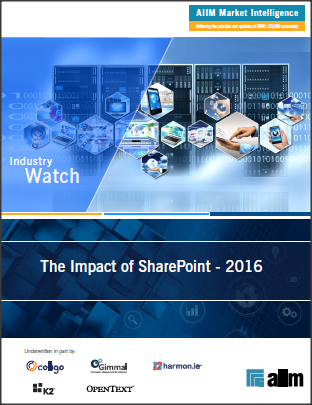
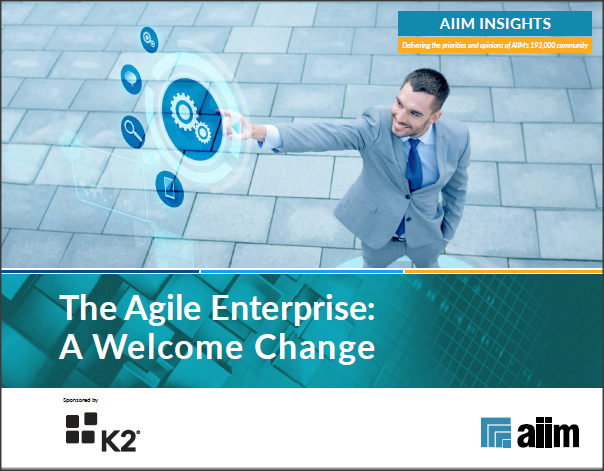
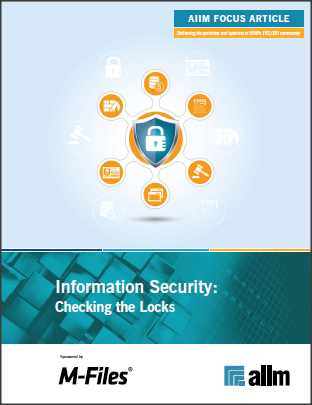


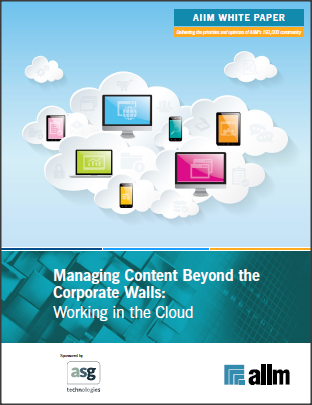
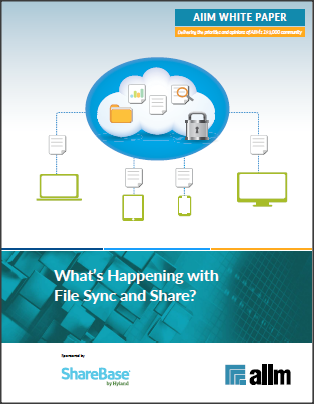
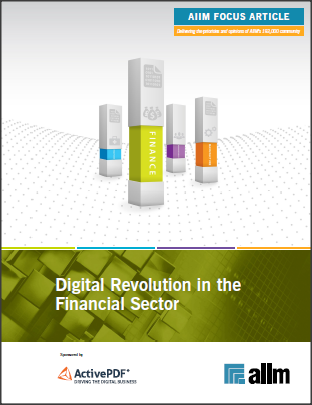
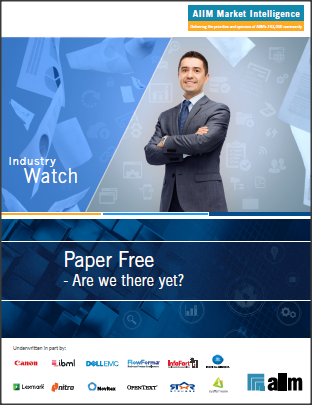 Paper Free – Are we there yet?
Paper Free – Are we there yet?